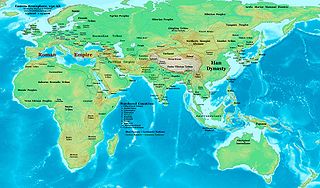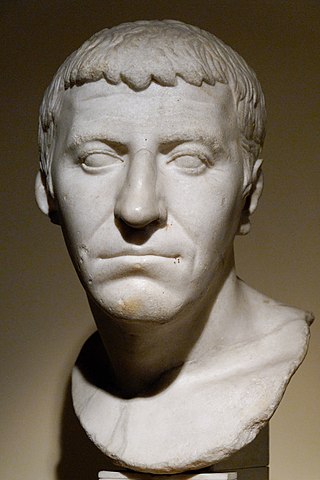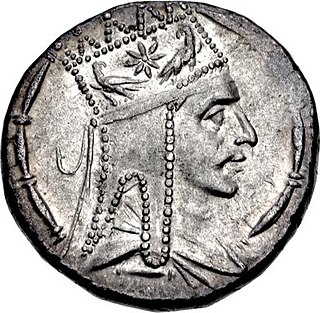AD 54 (LIV) was a common year starting on Tuesday of the Julian calendar. At the time, it was known as the Year of the Consulship of Lentulus and Marcellus. The denomination AD 54 for this year has been used since the early medieval period, when the Anno Domini calendar era became the prevalent method in Europe for naming years.

The 50s decade ran from January 1, 50, to December 31, 59. It was the sixth decade in the Anno Domini/Common Era, if the nine-year period from 1 AD to 9 AD is considered as a "decade".

The 60s decade ran from January 1, AD 60, to December 31, AD 69.
AD 51 (LI) was a common year starting on Friday of the Julian calendar. At the time, it was known as the Year of the Consulship of Caesar and Scipio. The denomination AD 51 for this year has been used since the early medieval period, when the Anno Domini calendar era became the prevalent method in Europe for naming years.

AD 59 (LIX) was a common year starting on Monday of the Julian calendar. At the time, it was known as the Year of the Consulship of Apronianus and Capito. The denomination AD 59 for this year has been used since the early medieval period, when the Anno Domini calendar era became the prevalent method in Europe for naming years.
The 160s decade ran from January 1, 160, to December 31, 169.
Year 69 BC was a year of the pre-Julian Roman calendar. At the time it was known as the Year of the Consulship of Hortensius and Metellus. The denomination 69 BC for this year has been used since the early medieval period, when the Anno Domini calendar era became the prevalent method in Europe for naming years.

Legio XII Fulminata, also known as Paterna, Victrix, Antiqua, Certa Constans, and Galliena, was a legion of the Imperial Roman army. It was originally levied by Julius Caesar in 58 BC, and the legion accompanied him during the Gallic Wars until 49 BC. The unit was still guarding the Euphrates River crossing near Melitene at the beginning of the 5th century.

Gnaeus Domitius Corbulo was a popular Roman general, brother-in-law of the emperor Caligula and father-in-law of Domitian. The emperor Nero, highly fearful of Corbulo's reputation, ordered him to commit suicide, which the general carried out faithfully, exclaiming "Axios", meaning "I am worthy", and fell on his own sword.

Legio IV Scythica, also written as Legio IIII Scythica, was a legion of the Imperial Roman army founded in c. 42 BC by the Roman general Mark Antony, for his campaign against the Parthian Empire, hence its other cognomen, Parthica. The legion was still active in the Roman province of Syria in the early 5th century.

Armenia, also the Kingdom of Greater Armenia or simply Greater Armenia or Armenia Major, sometimes referred to as the Armenian Empire under Tigranes II, was a kingdom in the Ancient Near East which existed from 331 BC to 428 AD. Its history is divided into the successive reigns of three royal dynasties: Orontid, Artaxiad, and Arsacid (52–428).

Vologases I was the King of Kings of the Parthian Empire from 51 to 78. He was the son and successor of Vonones II. He was succeeded by his younger son Pacorus II, who continued his policies.

The Battle of Rhandeia, was a military clash between the Armenian-Parthian and Roman armed forces in the spring of 62 in a place called Rhandeia. The Armenian army was led by Tiridates I the Parthian by Vologases I, and the Roman by Paetus.

Legio V Macedonica was a Roman legion. It was probably originally levied in 43 BC by consul Gaius Vibius Pansa Caetronianus and Gaius Julius Caesar Octavianus. It was based in the Balkan provinces of Macedonia, Moesia and Dacia. In the Notitia Dignitatum records from beginning of the fifth century, the legion was still stationed in Dacia, with detachments stationed in the east and Egypt.
The Arsacid dynasty, called the Arshakuni in Armenian, ruled the Kingdom of Armenia from 12 to 428 AD. The dynasty was a branch of the Arsacid dynasty of Parthia. Arsacid kings reigned intermittently throughout the chaotic years following the fall of the Artaxiad dynasty until 62, when Tiridates I, brother of Parthian King Vologases I, secured Arsacid rule in Armenia as a client king of Rome. However, he did not succeed in establishing his line on the throne, and various princes of different Arsacid lineages ruled until the accession of Vologases II, who succeeded in establishing his own line on the Armenian throne, which ruled the kingdom until its abolishment by the Sasanian Empire in 428.

Tiridates I was King of Armenia beginning in 53 AD and the founder of the Arsacid dynasty of Armenia. The dates of his birth and death are unknown. His early reign was marked by a brief interruption towards the end of the year 54 and a much longer one from 58 to 63. In an agreement to resolve the Roman–Parthian conflict in and over Armenia, Tiridates I was crowned king of Armenia by the Roman emperor Nero in 66; in the future, the king of Armenia was to be a Parthian prince, but his appointment required approval from the Romans. Even though this made Armenia a client kingdom, various contemporary Roman sources thought that Nero had de facto ceded Armenia to the Parthian Empire.

Roman Armenia refers to the rule of parts of Greater Armenia by the Roman Empire from the 1st century AD to the end of Late Antiquity. While Armenia Minor had become a client state until it was incorporated into the Roman Empire proper during the 1st century AD, Greater Armenia remained an independent kingdom under the Arsacid dynasty. Throughout this period, Armenia remained a bone of contention between Rome and the Parthian Empire, as well as the Sasanian Empire that succeeded the latter, and the casus belli for several of the Roman–Persian Wars. Only in 114 would Emperor Trajan conquer and incorporate it as a short-lived Roman province.
The Roman–Parthian Wars were a series of conflicts between the Parthian Empire and the Roman Republic and Roman Empire. It was the first series of conflicts in what would be 682 years of Roman–Persian Wars.
The Roman–Parthian War of 58–63 or the War of the Armenian Succession was fought between the Roman Empire and the Parthian Empire over control of Armenia, a vital buffer state between the two realms. Armenia had been a Roman client state since the days of Emperor Augustus, but in 52/53, the Parthians succeeded in installing their own candidate, Tiridates, on the Armenian throne.
Lucius Junius Caesennius Paetus was a Roman senator, and member of the gens Caesennia and Junia, who held several offices in the emperor's service. He was consul ordinarius for the year 61 as the colleague of Publius Petronius Turpilianus. Judith Ginsburg notes this made him the first novus homo to reach the ordinary consulship since Quintus Veranius 12 years before.









